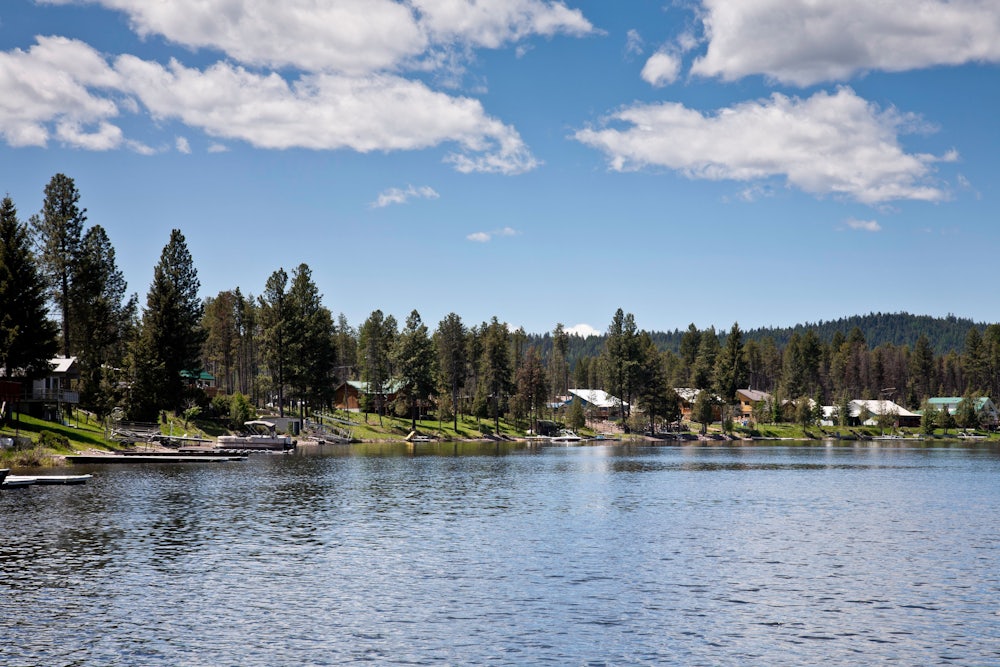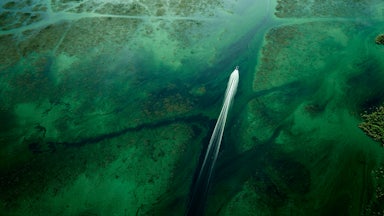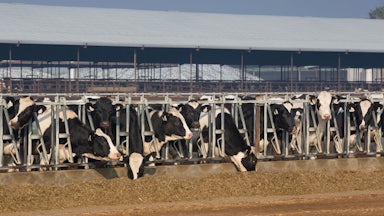Cheri Thompson was working at the flower shop when I called to talk about Seeley Lake’s sewer situation. “I call it The Conflict,” Thompson said. Seeley Lake, a rural blue-collar community in northwest Montana with just over 1,500 inhabitants, has been split in two by a seemingly pedestrian plumbing dispute that’s become a microcosm of a nationwide water crisis.
You wouldn’t be able to tell as an outsider. In the summer, the walk-up ice cream store off the highway sells strawberry soft serve, and convenience stores double as coffee shops and gift stores offering huckleberry jam and books about Montana. The population swells with tourists who rent Airbnbs or come to their summer cabins to camp, fish, and go boating and swimming.
What sustains the community in the summer is the lake, which is also the town’s main drinking-water source. This is where the conflict comes in.
Studies have documented rising nitrogen levels in the groundwater that leads to the lake, as well as fecal coliform in test wells, which is generally indicative of failing septic systems. All of the homes in Seeley Lake use septic systems. Because of groundwater contamination, any new developments, housing or commercial, that would further impact the groundwater have been halted. Any new septic systems installed would have to be higher quality, newer models, which could be costly.
Last summer, someone reported a harmful algal bloom known to be toxic to people, fish, birds, and other animals on the lake to Montana’s Department of Environmental Quality’s monitoring website, one sign of possible nutrient imbalances, likely from septic systems starting to fail.
The sewer board, supported by the Missoula City-County Public Health Department, decided in 2016 that the town was in need of a new and expensive sewer system. But not everyone in town was thrilled with the plan. The extra cost to locals in taxes would be about $150 a month; in a town where the average salary is just over $40,000 a year, many cannot afford that. Plus, only 650 people—those drawn into the sewer district—would be responsible for the costs. That was one of Thompson’s biggest concerns.
“The town was in two camps,” Don Larson, who has lived in Seeley Lake for over 40 years, told me. “It really divided the community.” He saw one camp for the sewer because it could help the town grow, while the other was against it because of the cost and a desire for more data. Larson landed in the latter camp.
Now aged 75, and $100,000 poorer after suing Seeley’s sewer board to try to delay the vote on financing the sewer system, Larson is selling his house. “Seeley’s kind of floundering right now, and I’m burnt out,” he said.
Seeley Lake’s crisis is just one example of a national problem. Communities across the United States that thrive on water are experiencing similar water-quality issues linked to an overload of nutrients. A sewer is often encouraged as the best and easiest solution, but in tourism-oriented communities, the people who remain after the days get shorter and kids go back to school are the people who pay for the system.
Other solutions do exist, but they range from the expensive to the weird.
As a kid, Brian Baumgaertel would spend summers in Cape Cod. The region never left him, and 15 years ago he decided to make it his home.
“It’s a pretty unique and special location,” he told me. “There’s a lot of places that are along the seaside, but not a lot of places that are Cape Cod.”
Baumgaertel said he doesn’t have the perspective of the old-time Cape Codders who have watched the water degrade, but people talk. “You hear stories of somebody who will say, ‘When I was a kid, we came here in the ’60s, and we’d take our boat out and there would be no algae,” Baumgaertel said. “And now we go out in the bay and it’s green.”
Baumgaertel, the director of the Massachusetts Alternative Septic System Test Center, said scientists posited that nutrient contamination in the Cape was coming from septic systems as early as the late 1990s, but it took a long time for people to get moving in the right direction. As with climate change, Baumgaertel said it’s difficult to get people to think about existential threats as reality.
Cape Cod had the right type of soils for septic systems to work, said Andrew Gottlieb, executive director of the Association to Preserve Cape Cod. The reason they stopped working, Gottlieb added, was because there has been more development in Cape Cod since the 1980s than in the cumulative time that had passed since the pilgrims arrived. It became such an obvious problem that even the biggest skeptics couldn’t ignore it.
In addition to the green bays and ponds, the nutrient loading destroyed all the eelgrass, habitat for the Cape’s signature shellfish and scallops. Large floating algal mats appeared on top of the water, and the floor went from sand to muck.
Lakes became ideal habitat for cyanobacteria blooms, which can produce powerful poisons. Public health concerns resulted in closures of beaches and towns on the Cape. “Everything that could have gone wrong has,” Gottlieb said.
Gottlieb has learned that money is almost always the fundamental roadblock on these issues. So figuring out who actually has the requisite funds, and taxing accordingly, is the key to progress.
“People can question the science. They question the modeling, they question the engineering, and at the end of the day they’re just denying spending money. All of those things have an element of kicking the can down the road financially,” he said.
One solution was the adoption of an overnight tourist tax on the Cape that adds 2.75 percent to a home rental or hotel bill, which goes directly to a municipal wastewater fund; since 2018, $97 million in project funds have been provided to towns in support of water-quality projects. The tourist economy is important, Gottlieb said, but with a four-week summer peak of infrastructure use, it brings with it costs the year-round population cannot afford to address.
Cape Cod, like many resort communities, has a balance of people with McMansions and those who work service industry jobs. “Inland, it’s normal people who work at Cooke’s Seafood. They do the cleaning in the Airbnb houses or in the motels. They’re lifeguards. They’re the [Department of Public Works] workers just trying to keep the road in decent shape. There are a lot of people who are struggling to live here,” Baumgaertel said, adding that putting the cost of a wastewater treatment plant on their backs is a big ask.
The soil in the Florida Keys, unlike that in Cape Cod, was bad for septic systems from the start.
The limestone down there is easily dissolvable. “If you’re putting your waste in the ground it’s not great, because there’s a high probability that it can move pretty quickly,” said Erin Lipp, professor of environmental health science at the University of Georgia. Development then made the problem even worse, she added: Because everyone who lives in the Keys wants to be on the water, canals were dug to create more water access, reducing the amount of soil that is supposed to process waste.
Lipp vacationed in the Keys a couple of times when she was young but only started getting interested in septic system issues when she started her master’s work on water quality in the Keys. Her studies tried to assess how fast human bacteria from septic systems could move out into the coastal waters.
Lipp and her fellow researchers flushed benign viruses and dyes down toilets and set up underground and offshore monitoring stations to watch the dyes move from the plumbing to the water.
“It was pretty striking,” Lipp says. The virus showed up in some canals in six hours. Some of the viruses and dyes made it all the way to the coral reef eight miles from shore and attached to the corals. Luckily, Lipp said, the human viruses didn’t really affect the reefs. The coral just sloughed them off.
As studies like these came out, a 20-year period of funding was kicked off for adding sewer systems to the Florida Keys. While this was spread out over a long time period, “it was a lot of money,” Lipp said. The last sewer system was finished in 2017. Despite the lag time and fairly large assessments on homeowners, the Keys have become a rare success story for updating sewage systems.
These aren’t the only possible solutions to wastewater problems, which can spark remarkably creative feats of environmental engineering. The Swedish island of Gotland, for instance, has started using unique portable toilets for summer events, with the urine collected from them processed into a dry fertilizer that can be used to grow barley that is then brewed into beer.
But by and large, wastewater solutions are hard to implement because the problem is often invisible. It involves pipes and tanks underneath the surface that people want to think about maybe once and never again. Anna-Lisa Castle, policy director for clean water and equity at the Alliance for the Great Lakes, said it’s hard to build political will around an invisible issue.
President Biden’s Bipartisan Infrastructure Law, which passed last year, threw a program designed to respond to communities’ wastewater issues into the spotlight—the State Revolving Fund. Created under 1987 amendments to the Clean Water Act, the SRF uses federal and state money to come up with loans for projects related to municipal wastewater facility construction; so-called nonpoint source pollution—which is how septic leachate is categorized; and decentralized wastewater systems, among other things.
“Because we have not invested in clean water infrastructure to the degree we’ve needed to, it becomes politically challenging at the local level to fund some of these things,” Castle said. Historic levels of funding have been added to SRF programs with the passage of the infrastructure bill, she added. With almost $12 billion nationally earmarked for wastewater and nonpoint source pollution projects and $5 billion for small or disadvantaged communities to address water contamination, the infrastructure package might bring relief to The Conflict in Seeley.
When I spoke to Cheri Thompson in Seeley Lake, she had just finished mowing and raking a trail for a triathlon the town was hosting to benefit a nondenominational church group that works with disenfranchised kids. In spite of the dispute that animated the town, the community still shows a remarkable amount of solidarity.
She told me the Seeley Lake Sewer Board, of which she is a member, has decided to put extra effort into testing, trying to figure out where the water-quality problem is coming from. From there, the plan is to hire an engineering company to tell the board where best to drill new test wells and guide it toward figuring out a solution to the lake contamination problem.
I asked her how she would solve Seeley’s problem, given a magic wand. Thompson paused.
“What we really are going to find is that we are going to have multiple answers,” she said. Maybe they’ll come up with a neighborhood-based solution and some neighborhoods will install upgraded septic systems. Maybe the payment scheme will vary per neighborhood based on how much the neighborhood is contributing to the problem.
Baumgaertel, in Cape Cod, thinks the best solution is a mixed solution. But if he had a magic wand for Cape Cod, he first thought he’d sewer the whole place, with the magic wand taking the money out of consideration.
Tourist communities like the Keys, the Cape, and Seeley all have an element of magic to them. In a lot of ways, that magic relies on a façade of unknowing. As long as there’s sun and wine and water, it’s all good.
But that magic might not be maintained if the water those places rely on is green all summer long with toxic algae. And if green water leads to beach closures and a reduction in the tourists many water communities rely on, the communities will have lost their economies, their water, and their character. While wastewater issues can first show up as occasional aesthetic concerns, left untreated, the problem quickly becomes existential.
This story was produced with funding from the Crown Reporting Fellowship at the University of Montana.










